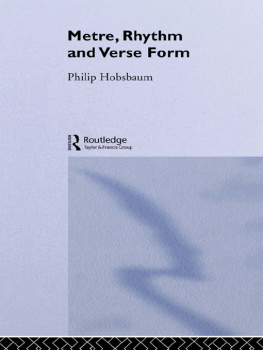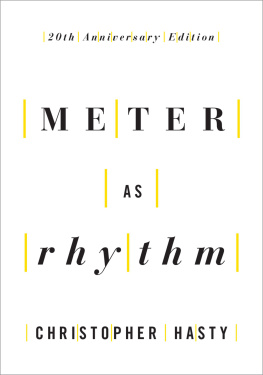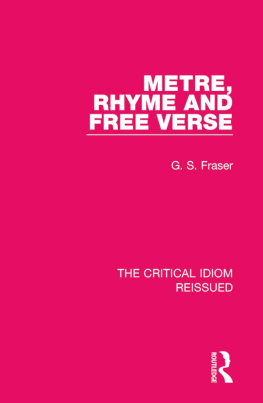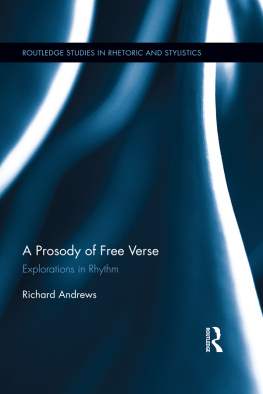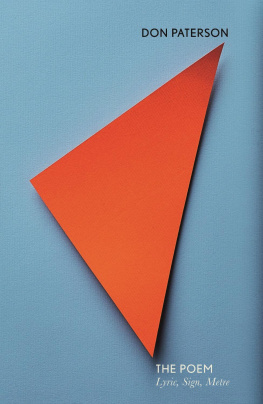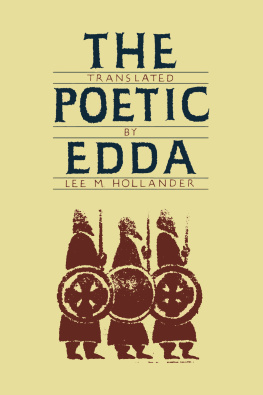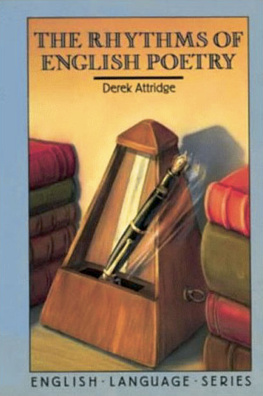Hobsbaum - Metre, Rhythm and Verse Form
Here you can read online Hobsbaum - Metre, Rhythm and Verse Form full text of the book (entire story) in english for free. Download pdf and epub, get meaning, cover and reviews about this ebook. City: London, year: 2006;1996, publisher: Taylor & Francis (CAM);Routledge, genre: Children. Description of the work, (preface) as well as reviews are available. Best literature library LitArk.com created for fans of good reading and offers a wide selection of genres:
Romance novel
Science fiction
Adventure
Detective
Science
History
Home and family
Prose
Art
Politics
Computer
Non-fiction
Religion
Business
Children
Humor
Choose a favorite category and find really read worthwhile books. Enjoy immersion in the world of imagination, feel the emotions of the characters or learn something new for yourself, make an fascinating discovery.
Metre, Rhythm and Verse Form: summary, description and annotation
We offer to read an annotation, description, summary or preface (depends on what the author of the book "Metre, Rhythm and Verse Form" wrote himself). If you haven't found the necessary information about the book — write in the comments, we will try to find it.
Metre, Rhythm and Verse Form — read online for free the complete book (whole text) full work
Below is the text of the book, divided by pages. System saving the place of the last page read, allows you to conveniently read the book "Metre, Rhythm and Verse Form" online for free, without having to search again every time where you left off. Put a bookmark, and you can go to the page where you finished reading at any time.
Font size:
Interval:
Bookmark:

The publishers would like to express their thanks to the copyright holders for permission to reprint from the following:
Still-Life by Elizabeth Daryush, Selected Poems , 1985, Carcanet Press Limited; To a Snail by Marianne Moore, The Complete Poems of Marianne Moore , 1984, Faber & Faber Ltd; Considering the Snail by Thom Gunn, My Sad Captains , 1993, Faber & Faber Ltd; Revenge Fable by Ted Hughes, Crow: From the Life and Songs of the Crow , 1972, Faber & Faber Ltd; The Snow Man by Wallace Stevens, Collected Poems , 1955, Faber & Faber Ltd; The Widows Lament in Springtime by William Carlos Williams, Collected Poems , 1994, Carcanet Press Limited; Ghosts by Peter Redgrove, The Moon Disposes , 1987, Seeker and Warburg; My Cats by Stevie Smith, The Collected Poems of Stevie Smith . Copyright 1972 by Stevie Smith. Reprinted by permission of New Directions Publishing Group and Penguin 20th Century Classics/James MacGibbon; In the village pond by James Kirkup, Shooting Stars , 1992, Hub Editions; In a Station of the Metro by Ezra Pound, Collected Shorter Poems , 1968, Faber & Faber Ltd; Siesta of a Hungarian Snake by Edwin Morgan, Collected Poems , 1990, Carcanet Press Limited; Paid on both sides by W.H.Auden, Collected Poems , 1976, ed. Edward Mendelson, Faber & Faber Ltd; Gerontion, The Waste Land and Little Gidding by T.S.Eliot, Collected Poems 19091962 , 1974, Faber & Faber Ltd; Crossings xxxvi by Seamus Heaney, Seeing Things , 1991, Faber & Faber Ltd; Station Island by Seamus Heaney, Station Island , 1984, Faber & Faber Ltd; Lady Lazarus by Sylvia Plath, Ariel , 1968, Faber & Faber Ltd; Sonnet: To Eva by Sylvia Plath, Collected Poems , edited with an introduction by Ted Hughes, 1981, Faber & Faber Ltd.
Every effort has been made to contact the copyright holders concerned. Where credit has not been properly given, we would invite copyright holders to contact the publisher in the first instance.
English verse is a succession of syllables. Some are strongly emphasized, some are not. The pattern of metre is set up by the way in which heavily stressed syllables are interspersed with more lightly stressed syllables. The metrical patterns are termed feet. The main types of feet are as follows.
The iamb: this consists of one lightly stressed syllable followed by one stressed syllable. Revolve, behind, before, aloud are all iambs.
The trochee is the iamb reversed. It consists of one stressed and one lightly stressed syllable. Forward, backward, rabbit, orange are all trochees.
These two metrical feet, iamb and trochee, each consist of two syllables. But it is possible to have three syllables in a foot, as follows.
An anapaest consists of two lightly stressed syllables followed by one stressed syllable. Repossess and understand are examples.
A dactyl is an anapaest reversed. It consists of one stressed syllable followed by two lightly stressed syllables. Pulverize and agitate are dactylic feet.
The intermediate pattern, when a stressed syllable is flanked fore and aft by two lightly stressed syllables, is called an amphibrach: redouble, confetti.
Such examples as are given here should not be taken to be fixed, as a mathematical quantity would be. They should be regarded rather as indicators. The weight of stress can vary appreciably according to context, especially when that context departs from a metrical norm.
What is a metrical norm? In order to form a line of verse, each foot is repeated several times. The more times the foot is repeated, the longer the line becomes.
It should be emphasized that one rarely comes across a line that is entirely anapaestic, or entirely dactylic, or entirely amphibrachic. Usually, with a line made up of trisyllabic feet, there is a mixture of patterns.
A dimeter is what we would call a line consisting of two feet. An iambic dimeter would be The passive heart. A trochaic dimeter would be chimney sweeper. One that is anapaestic is at the end of the road. The equivalent dactyl would be Come along rapidly and the equivalent amphibrach would be As midsummer flower.
In practice this particular pattern tends to be mixed, as in the following start of an anonymous song of the sixteenth century:
Over the mountains
And under the waves,
Over the fountains
And under the graves.
The first and third lines are dactylic dimeters. The second and fourth lines, also dimeters, are amphibrachic, and docked of a final syllable.
The dimeter is rare, and the trimeter, in which three stressed syllables are in question, is scarcely less so. The world a hunting is (William Drummond, 15851649) is an example of iambic trimeter. The trochaic equivalent is Rose-cheeked Laura, come (Thomas Campion, 15671620), with the final syllable docked. An example of anapaestic trimeter is As we rush, as we rush, in the train (James Thomson, 183482). A dactylic trimeter in a pristine state would be merrily, merrily, merrily, but the final syllable is usually docked.
Comparatively few poems of any worth have been written in very short lines. However, the American poet J.V.Cunningham (191185) was a master in this form of verse. Here is the poem from which an example of iambic dimeter, cited earlier, was culled. It is called Acknowledgment and concerns the way in which an unimpressive life can be made meaningful in a literary text:
Your book affords
The peace of art,
Within whose boards
The passive heart
Impassive sleeps,
And like pressed flowers,
Though scentless, keeps
The scented hours.
More usually, short lines are variegated, in the manner of John Skelton (14601529). The mode is called Skeltonics, after him. His lyric To Mistress Margaret Hussey begins:
Merry Margaret,
As midsummer flower,
Gentle as falcon
Or hawk of the tower.
The first foot of the first line is a docked dactyl, with a syllable elided from Merry. We know this is docked, or truncated, because the mode of the poem is couched predominantly in feet of three syllables; that is to say, trisyllabic feet. Predominantly these feet are amphibrachic dimetersAs midsummer flowerthough there are also truncated dactylic dimetersGentle as falcon.
Modern instances of Skeltonics have been produced by Robert Graves (18951985), who was a great admirer of the older poet, and by Lilian Bowes Lyon (18951949). She has them as dimeters in her poem Snow Bees. This begins:
Close friends we have
Still in the womb,
Or dumb in the grave.
About us they come.
Trimeters displaying three sets of triple feet are used mainly for satirical purposes. There is little good poetry written in this pattern, but some that is entertaining. Winthrop Mackworth Praed (180239) uses an amphibrachic trimeter to celebrate the season. This was a period of balls and parties held in London each year in the nineteenth and twentieth centuries, and discontinued only in recent times. It acted as a marriage mart for dbutantes; that is to say, young ladies thought socially acceptable enough to have been introduced to the reigning monarch. (Gay here has its original use of merry or blithe.)
Good-night to the Season! tis over!
Gay dwellings no longer are gay;
The courtier, the gambler, the lover,
Are scattered like swallows away.
Notice that the alternate lines are docked of a syllable.
However, the shorter line that is most frequently used is not the dimeter or the trimeter but the tetrameter. The tetrameter is a four-stress line, whose beat is provided by the syllables that bear a heavy stress, as distinct from those that are lightly stressed.
Font size:
Interval:
Bookmark:
Similar books «Metre, Rhythm and Verse Form»
Look at similar books to Metre, Rhythm and Verse Form. We have selected literature similar in name and meaning in the hope of providing readers with more options to find new, interesting, not yet read works.
Discussion, reviews of the book Metre, Rhythm and Verse Form and just readers' own opinions. Leave your comments, write what you think about the work, its meaning or the main characters. Specify what exactly you liked and what you didn't like, and why you think so.

